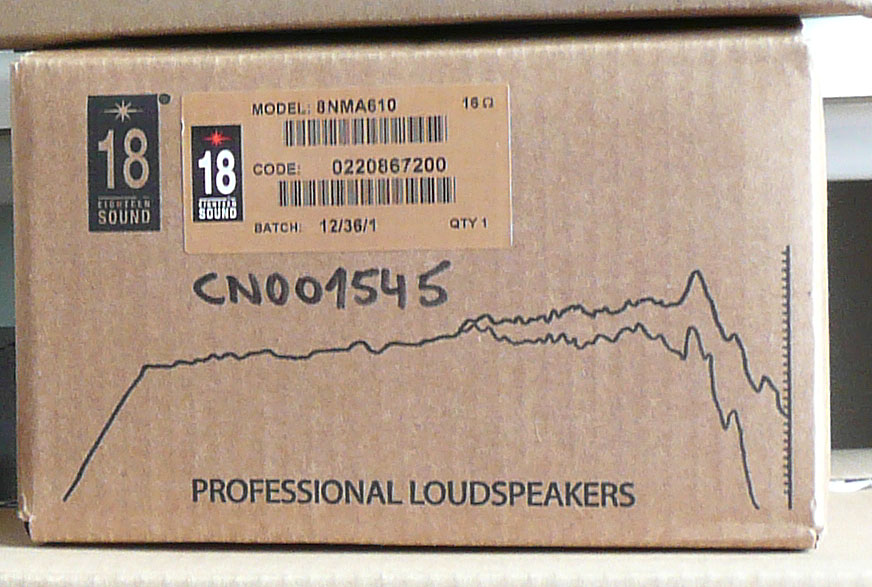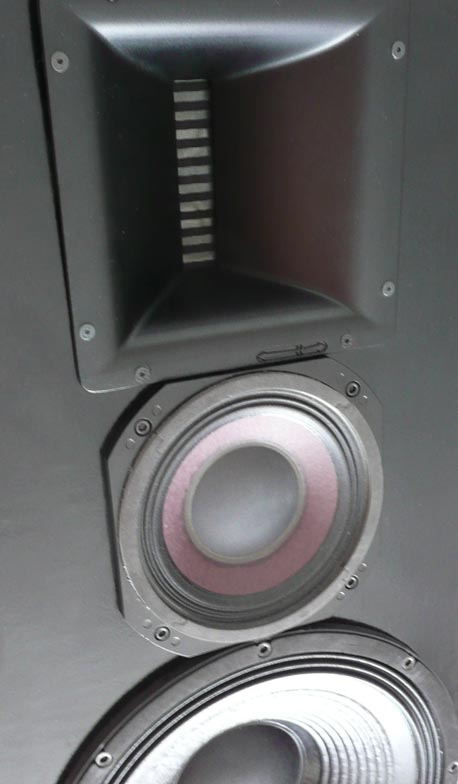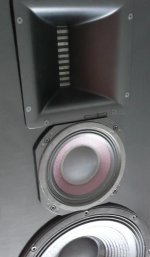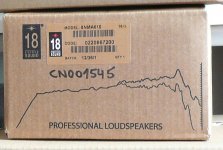A-hA! Turns out you were completely RIGHT! LOL 😀

At least it's mostly all 2nd order, and not 3rd order which stays just around 2% until under 1kHz.
Glad it did work out for you!
I still want to try the suggestion of others to build a large, stuffed rear chamber in place of the stock plastic back-box with felt, to see how much reduction in HD I can attain.
Why not begin with what prevents the tweeter from getting damaged. This question is difficult to answer because it depends on such things as the response of the drivers, their location with respect to each other, the crossover point's proximity to issues such as breakup, low frequencies for the tweeter, mismatch due to anomalies in the polar response.What order and type would you suggest for the first estimation?
That made me laugh. Well below almost no power, is stupidly low power.BTW, Ralph Karsten, from Atmasphere, told me SETs have vanishingly low distortion if used well below their rated power.
A scope won't work all that well unless you have some way to accurately record peaks.For the last couple on months, I have been driving my 99db/w horn-loaded cone mid-range from a Class A Triode-wired EL84 tube amp. It is however, a push-pull, as opposed to an SET. It does about 6 watts/channel. I have been investigating JUST how much power it takes, while I listen to music. I've been using a digital LED read-out volt meter, to determine this. 1/4 of a watt was the most I read. But, then (!!) I was properly scolded and told that my make-shift method leaves quite a bit to be desired. According to my amplifier gurus, the only *proper* way to measure would be to use an Oscilloscope.
Bob Cordell did a test over a decade ago.
Please post your results here when you do. I have a pair of TPLs, currently on loan to a friend, and have been told of the improvements from the large rear chamber, but have yet to see the data.I still want to try the suggestion of others to build a large, stuffed rear chamber in place of the stock plastic back-box with felt, to see how much reduction in HD I can attain.
The impedance is easily dealt with passively.This driver exhibits also a very flat impedance, especially with AIC engaged, which is good for SETs.
Difficult to deal with passive is subjective. There's little that I haven't managed to do passive or active.but difficult to deal with passive xo - an interim problem for me, but later with DSP a no problem.
I can see how this is more complicated. C to C can be less critical due to the lower directivity where the nulls are beyond the beam.I could achieve all of the above with a horn, but then center-to-center distance to the (already large) tweeter becomes an issue.
I can't tell you what to do here, but there are always good tradeoffs 😉But I know you have a good point. Maybe I should consider letting go of the SETs constrain and allowing lower sensitivity, or using a horn and live with expected lobbing and reduce the xo point. A world of tradeoffs 🙁
A scope won't work all that well unless you have some way to accurately record peaks.
Bob Cordell did a test over a decade ago.
Well, I certainly do appreciate this !! I would have an audiophile-grade cup of coffee with you, anytime !!
I still want to try the suggestion of others to build a large, stuffed rear chamber in place of the stock plastic back-box with felt, to see how much reduction in HD I can attain.
I did this but didn't measure distortion. Built a chamber about the same width as the membrane, about 12" deep, and varying height. Stuffed with fiberglass of varying density: starting very loose about half way into depth and ending compact. And an open end at the back. It was about 1.5 liters. Result? Same frequency response as with plastic cover, sounded the same to me. Didn't measure distortion though. Down the road, when I get to refine this I plan to build a shorter, wider chamber with very light stuffing.
If you dig the previous threads, I recall someone concluded the distortion was likely related to the AMT "cassette" being rather loose as delivered from factory. The cassette (term he used) would be the steel rectangle holding the membrane into the larger steel frame. He said it was kind of loose and used tape around the edges to make it thicker and allegedly get rid of the resonance. Again, something for me to look into down the road.
Why not begin with what prevents the tweeter from getting damaged. This question is difficult to answer because it depends on such things as the response of the drivers, their location with respect to each other, the crossover point's proximity to issues such as breakup, low frequencies for the tweeter, mismatch due to anomalies in the polar response.
Here's why comes to mind regarding your questions:
- response of the drivers: manufacturers response curves. Seems OK to me.
- their location with respect to each other: vertically on axis, center to center distance about 9", will be in independent modules so can be displaced front-to-back in search of time-alignment.
- the crossover point's proximity to issues such as breakup: looking at impedance and frequency response, breakup doesn't seem to be a big issue around 1.7kHz.
- low frequencies for the tweeter: Beyma recommends 1kHz 2-order xo rated to 80W. I plan to xo much higher so should be safe.
- mismatch due to anomalies in the polar response: this I'm not sure how to answer. The TPL-150H keeps a rather constant dispersion horizontally at 80 degrees, and about 30 degrees vertically. I have little info from the 10", but I'm assuming it behaves as a "typical" 10" direct radiator.
with all this said, what type and order of passive xo would you recommend?
Please post your results here when you do. I have a pair of TPLs, currently on loan to a friend, and have been told of the improvements from the large rear chamber, but have yet to see the data.
10-4!
Here is the info I found:
TPL-150H back chamber mods
Beyma TPL-200 felt pad removal?
Beyma 12p80nd + TPL-150
TPL150 DIY
I want to try out standard polyfill (from Parts Express) but I also have a very "special" stuffing material from Germany that I'd like to try out. 😉
Guessing - a 10" driver might begin to be directive around 900Hz. Might have the first breakup mode around 1k8. Might have the breakup peak around 2k6. This could make the crossover good between 1k4 and 1k8.
Does the tweeter have a comparable directivity index in that region?
Does the tweeter have a comparable directivity index in that region?
Thank you for that.10-4!
Here is the info I found:
As the design I plan to use mine in is a wide thin unit a la SF Strad I might try a large volume tapered tube, but bifurcated behind the driver.
Ramallo's post here was most informative.
I might be mistaken but looking at the 18S website I think I see the first breakup mode at 1.7kHz. It is fine to cross here but this would be the upper limit.the crossover point's proximity to issues such as breakup: looking at impedance and frequency response, breakup doesn't seem to be a big issue around 1.7kHz.
Reasonable assumption for now. It should be somewhere around 90 degree beam width.I'm assuming it behaves as a "typical" 10" direct radiator.
If you need a number then second order is as good a starting point as any. You might try getting the breakup mess a couple of dozen dB down, and the region where the TPL significantly loses its directivity down as well, preferably beginning from where it matches the woofer (or the other way around). If you can't get the phase together and the response right then add another component or so. Then you can investigate the polar regions (lol), and start again.with all this said, what type and order of passive xo would you recommend?
Thank you for that.
As the design I plan to use mine in is a wide thin unit a la SF Strad I might try a large volume tapered tube, but bifurcated behind the driver.
Ramallo's post here was most informative.
Would you mind sharing what you'll use as midrange for your TPL?
FWIW, in my experiment the tapered volume didn't do much for sound nor frequency response. Probably a deep enough chamber (like 20cm deep), constant cross section and lightly filled would be enough. And the light filling starting light 10cm away from the membrane in line with Ramallo's findings. Also FWIW, this is what I plan to do with mine.
It's unfortunate they didn't make it an 8" instead of 10".
But they did!
Eighteen Sound 8NMA610.
Extremely difficult to get hold of as they're not on Eighteen Sound's website, and were never on sale to the general public, but really a bespoke special version (of the standard 8NM610 driver) made specially for KV2 Audio, who use them for their VHD2.0 and ESR215 models. I managed to buy two of these drive units directly from KV2 Audio about 8 years ago.
I've got them as mids in my 3-way, inbetween Beyma TPL150H tweeters and Faital Pro 15XL1400 woofers. Crossovers are 275 Hz and 2750Hz with 30dB/oct LR linear phase slopes using individual driver FIR correction via six channels of OpenDRC.
Attachments
Last edited:
Glad you found it interesting. I first read it when new and it just confirmed for me that all the "you only need flea watts" stuff was utter bollocks. My own experiments with my very efficient FLH system and 50W class A PP tube amp had raised my suspicions earlier.Well, I certainly do appreciate this !! I would have an audiophile-grade cup of coffee with you, anytime !!
ATC SM75-150Would you mind sharing what you'll use as midrange for your TPL?
I plan to use a much larger volume than you did, hopefully enough that the driver thinks it's effectively operating dipole. No stuffing near the rear.FWIW, in my experiment the tapered volume didn't do much for sound nor frequency response. Probably a deep enough chamber (like 20cm deep), constant cross section and lightly filled would be enough. And the light filling starting light 10cm away from the membrane in line with Ramallo's findings. Also FWIW, this is what I plan to do with mine.
Thank you for that.
As the design I plan to use mine in is a wide thin unit a la SF Strad I might try a large volume tapered tube, but bifurcated behind the driver.
Ramallo's post here was most informative.
I agree. Makes me wonder how my other AMT's would perform in "dipole" operation, but with a stuffed back-chamber.
But they did!
Eighteen Sound 8NMA610.
Extremely difficult to get hold of as they're not on Eighteen Sound's website, and were never on sale to the general public, but really a bespoke special version (of the standard 8NM610 driver) made specially for KV2 Audio, who use them for their VHD2.0 and ESR215 models. I managed to buy two of these drive units directly from KV2 Audio about 8 years ago.
I've got them as mids in my 3-way, inbetween Beyma TPL150H tweeters and Faital Pro 15XL1400 woofers. Crossovers are 275 Hz and 2750Hz with 30dB/oct LR linear phase slopes using individual driver FIR correction via six channels of OpenDRC.


Nice! Do you know if these can be purchased anywhere?
ATC SM75-150
Very nice driver. Where did you purchase them from? I understand these aren't available for DIY buyers anymore.
A while back I saw Jeff Bagby's review/analysis of these, and his use of them with Raal tweeters. Too bad I had purchased the TPL already.
- Status
- Not open for further replies.
- Home
- Loudspeakers
- Multi-Way
- Help think through crossover: TPL-150H & 10NDA610

